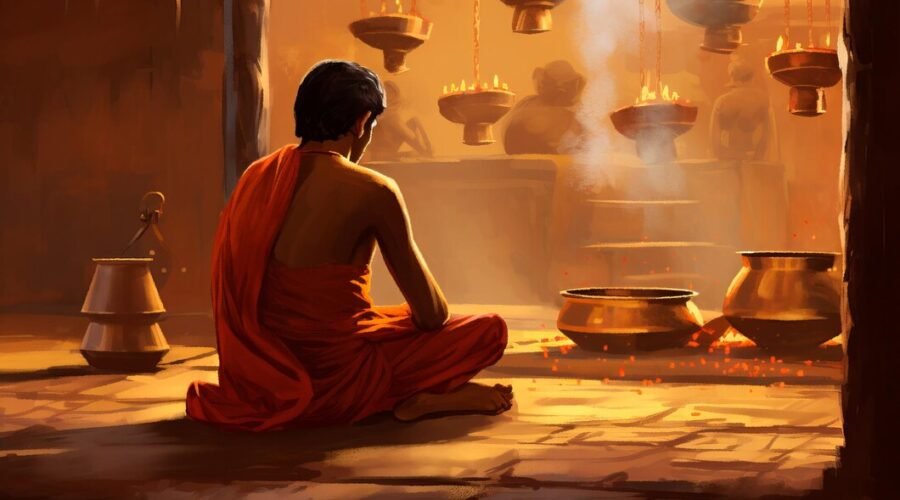What is Puja and Why Should We Perform It?
What is Puja, and Why Is It Important to Do It?
Puja is the science and art of calling upon and worshiping the living presence of God with love and devotion. It was revealed by the ancient sages and has been passed down unchanged for thousands of years.
The Vedas, Puranas, and Tantras are the sources of the Sanskrit mantras and customs of traditional puja. Offering our sincere devotion to the Lord of our hearts is the primary purpose of puja.
Puja is an auspicious method to commemorate life milestones like birthdays, anniversaries, moving into a new home, or any other occasion where you want to fervently worship God to bring benefits to you and your family.
Having a puja performed at home bestows the household with divine blessings. The holy words and rituals of conventional worship drive out evil spirits and infuse the house with a palpable sense of good fortune.
Puja is a type of ceremonial worship in which offerings like as flowers, fruit, prepared food, incense, etc. are made.
Yajña is a religious ceremony in which offerings such as ghee, havan samagri, sticks, etc. are placed into a sanctified fire. (Identical to havan or homa).
1. Punyaha Vachana: a cleansing ritual performed following a birth, death, or any other event that has resulted in pollution of the environment or oneself.
2. General Puja: a ceremonial offering-making ritual to one’s preferred god in order to express gratitude, ask for benefits, or just to “connect” with the divine. There is no havan, or fire offerings, in this ceremony.
3. Satya Narayana Puja: This comprehensive puja calls for the blessings and goodwill of all the gods by offering sacrifices to each of them. The ceremony’s main deities are Vishnu and Lakshmi, and its goal is to express gratitude.
4. Lakshmi-Narayana Puja: This fire ritual is performed to call forth the grace and blessings of the Almighty Being manifesting as both Lakshmi and Narayana.
5. Stepping inside a new house is Vastu Shanti / Griha Pravesha: To balance any energy imbalance in the house or workplace, a Vedic ceremony was performed. Every enclosed place generates an energy field that is further influenced by the interpersonal dynamics and auras of those utilizing it. This ceremony’s goals are to eliminate all obstacles and transform bad energy into a positive, helpful force.
6. Ganesha Homa: A fire ritual to achieve astrological harmony and empowerment as well as to remove all obstructions. The wisdom principle is Ganesha. This ceremony awakens the enlightened mind, the dormant principle of wisdom. This is also an extremely effective way to address issues in one’s birth chart that arise from transits through unfavorable periods (Dashas) or natal influences. The ritual gives one the ability to deal with their Karma in an efficient and positive way.
7. Navagraha Shanti: This is a ceremony to call upon the Nine Planetary deities’ blessings. We experience the good and bad effects of our Karma through the Nine Planetary deities, also known as Grahas. This ceremony, which can be performed with or without fire as a medium, is performed to offer offerings to them and to call upon their blessings so that we might fully utilize both positive and negative Karma as means of enlightenment. Bad Karma is not “removed” by this ceremony; rather, it is an empowerment ritual.
8. Sudarshana Homa: This is a fire ritual used for spiritual or bodily protection. The personification of Lord Vishnu’s Discus is called Sudarshana. It is symbolic of the ubiquitous Cosmic Mind. One of the “wrathful” gods, Sudarshana is called upon, along with Narasimha, to shield the aspiring spiritualist from any evil forces that might be interfering with their life or practice. The ceremony also functions as a kind of exorcism, driving out elementals and other unruly astral beings while also breaking spells and curses.
9. Hayagriva Puja: Hayagriva is the Buddhist and Hindu god of wisdom and cunning. Offerings are made to Hayagriva at this ceremony in order to maximize learning opportunities and actualize spiritual practice, as well as to evoke his blessings. If necessary, this can also be accomplished with fire offerings.
10. Durga Puja: The Great Goddess, Durga, sometimes goes by the name Kali. Offerings are made in this ceremony to express our gratitude to the Divine and to resonate with her all-encompassing spirit. Please talk to your priest about this. You can also accomplish this by reciting the relevant stotras or Chandi Paath.
11. Shiva Puja/Rudra-Abhishekam: This is a puja ritual performed to thank Lord Shiva and ask for his blessings. Rudra Japa and/or the Rudra Mahimna Stotra can also be used in conjunction with this.
12. Mrityunjaya Homa: This fire-ceremony invokes Lord Shiva’s blessing and bestows lifespan and health upon a person. can be done whenever one wants, including on anniversaries and birthdays.
13. Ayushya Homa: This is a fire ritual performed to ask for the gods’ blessing and to grant long life to a person. can be done whenever one wants, including on anniversaries and birthdays.
14. Lakshmi Puja/Homa: The goal of this ritual is to call upon Mother Lakshmi’s grace and blessings in order to attain wealth, contentment in the home, and overall wellbeing. It can be performed as a home practice, a puja, or both at once.
Shraddha Rituals A Brahmin (hiranya shraddha) can be as simple as providing raw food and Dakshina, or it might involve performing tarpana, which is the offering of water libations, or it can involve inviting two or three Bhoktas for a formal Shraddha feast.



